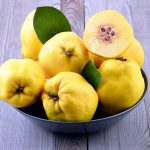 The quince, a relative of the apple and pear but too bitter to be eaten uncooked, derives its name from Cydonia, a port on the coast of Crete now known as Khania. Because the fruit was exported from Cydonia, the ancient Greeks called it melon Kudonion, meaning Cydonian apple. This name entered Latin as cydoneum, which later became cotoneum and was then adopted by French as cooin. In the late fourteenth century, English borrowed this French name, spelling it quine and creating a plural form spelt quince. Before long, however, people forgot that quince was supposed to be the plural form and began using it as a singular.
The quince, a relative of the apple and pear but too bitter to be eaten uncooked, derives its name from Cydonia, a port on the coast of Crete now known as Khania. Because the fruit was exported from Cydonia, the ancient Greeks called it melon Kudonion, meaning Cydonian apple. This name entered Latin as cydoneum, which later became cotoneum and was then adopted by French as cooin. In the late fourteenth century, English borrowed this French name, spelling it quine and creating a plural form spelt quince. Before long, however, people forgot that quince was supposed to be the plural form and began using it as a singular.
Hardy tree that produces a yellow, pear-shaped fruit.
A pear-shaped fruit with a lustrous golden exterior, possessing a tart, succulent pulp, and exuding a fragrant aroma. It is best suited for inclusion in preserves or jelly, or for use as a seasoning in various dishes, and ought to be cooked until it attains a translucent appearance to ensure it can be easily digested.
Behold the captivating quince, a fruit of remarkable character and texture. Hailing from the apple family, this gem finds its origins in the bountiful lands of Asia, thriving within temperate climates. As the season progresses, quinces reach their pinnacle of ripeness, typically in September or beyond, transforming into a resplendent hue of golden-yellow or subtle red, reminiscent of their apple or pear cousins. However, it is their unmistakable and potent fragrance that truly sets them apart. Possessing a unique and powerful aroma, quinces are best stored separately from other fruits to preserve their distinct essence. Delight in the enigmatic allure of this fruit, a true testament to nature’s artistry.
